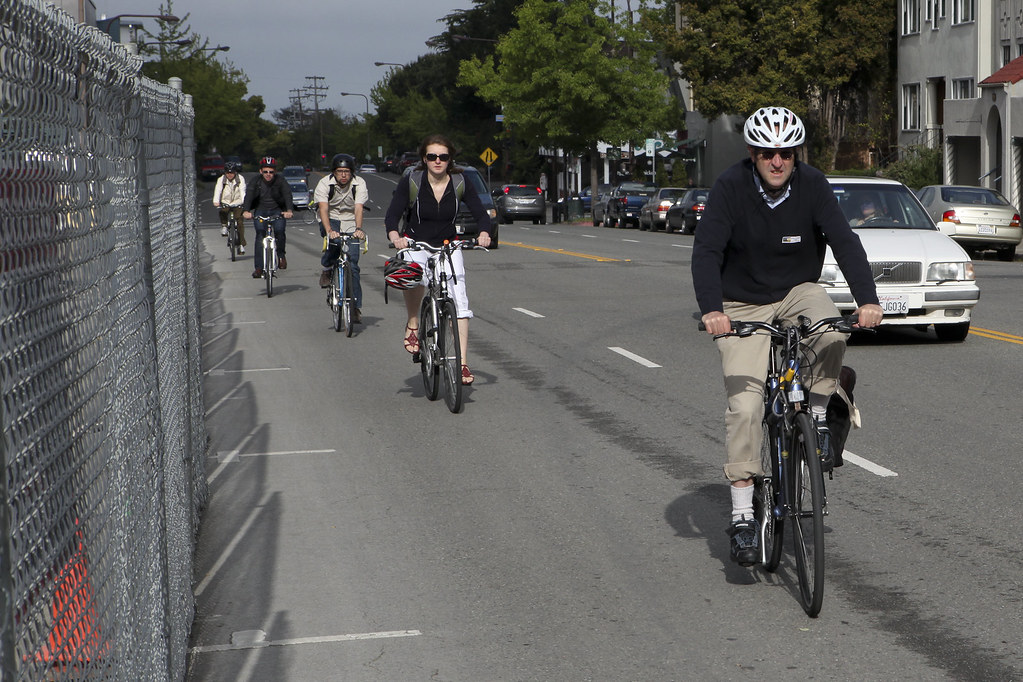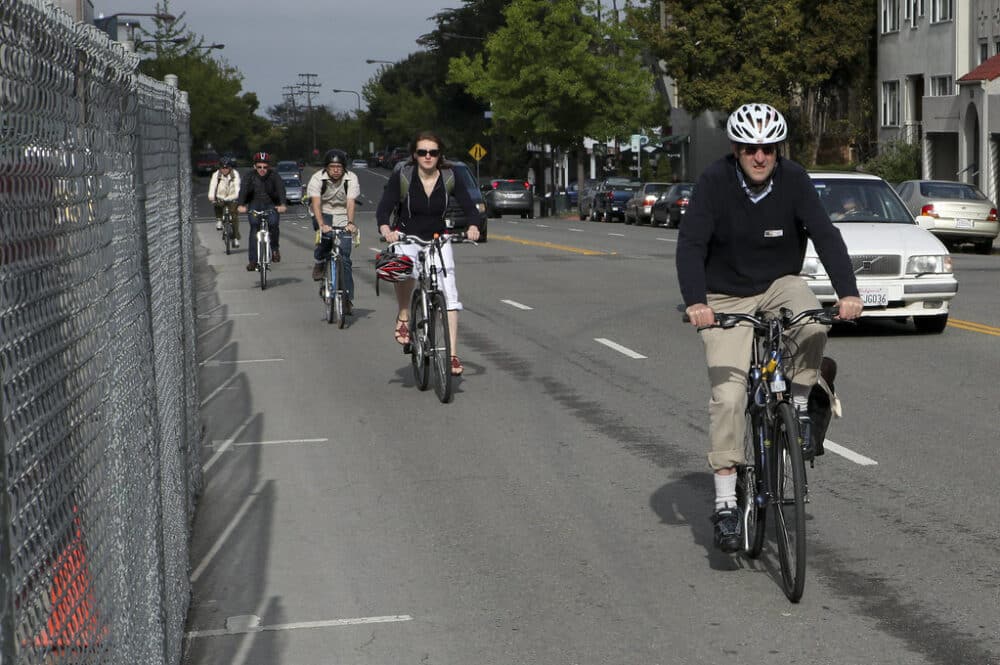This post may contain affiliate links, which help to keep Discerning Cyclist rolling. Learn more.
Have you ever wondered what the ‘commute by bike’ statistics are in Britain?
Are you keen to know how these compare with America’s bike commuting stats, or the ‘cycling to work’ stats across cycling hotbeds in Europe?
Or perhaps you’re just keen to learn some nifty new bike facts, like the average cycling speed or cost of a new pair of wheels in the UK?
If any of this applies to you, then be sure to read on, as we’ve compiled a list of 29 bicycle facts you probably didn’t know before, including a number of revealing bicycle commuting stats:

Commute By Bike Facts: What Percentage of People in the UK Use a Bicycle as Transportation to Get to Work?
- Starting with England’s cycling to work statistics, roughly 4 per cent of commuting trips were cycled in 2018. This figure has hardly changed in recent years. Comparatively, two-thirds of trips were made by cars or other vehicles. (National Travel Survey)
- In Wales, when asked ‘what mode of transport do you typically use to get to work?’, 4 per cent of respondents said they cycled. 76 per cent answered they usually went by car. (National Survey of Wales)
- Cycling to work numbers are much lower in Norther Ireland though, where a mere 1 per cent of journeys to work were made by bicycle, while 81 per cent were driven between 2016 and 2018. (Travel Survey for Northern Ireland in-depth report for 2016-2018)
Cycling To Work Stats: How Many Cyclists Are There Commuting in the US?

- It is certainly a growing trend across the Atlantic, but their ‘bike to work’ stats remain pretty uninspiring. The 2016 report on commuting from the Alliance for Biking and Walking found that 0.6 per cent of all American commuters biked to work in 2013, up from 0.5 per cent in 2009 and 0.4 per cent in 2005.
- As for how many people cycle to work in each state, though, findings from the League of American Bicyclists suggest that this can vary wildly. Between 2000 and 2013, the number of commuters in so-called ‘Bike-Friendly Communities’ increased by 105 per cent, and even by 31 per cent in ‘Non-Bike Friendly Communities’.
Cycling Statistics UK: What is the Average Bike Price in Britain?

- Mintel’s most recent UK Cycling Mark Report found that there were 2.5 million bike sales in Britain in 2019.
- Mintel‘s bike sales statistics also found that these 2.5 million bicycles were sold at a cumulative cost of £940 million, meaning people spend £381 on average on a new bike.
- On average, British households spend £1 a week on cycling. As such, this tots up at more than £1.4 billion annually. (Finder)
- This weekly £1 consists of 50p on the purchase of bicycles and 50p on bicycle repairs, accessories and other costs. (Finder)
- The average annual cost of cycling to work is estimated at £396 – in stark contrast, commuting by train costs approximately £625, and private car £3727. (Cycle Scheme)
Cycling Facts: How Many Bikes in the UK Are There?

Figures below for number of cyclists in UK countries concern the year of 2018 (besides Wales, figures from 2013-14):
- In England, 42 per cent of the population aged 5+ were found to own or have access to a bicycle, which totals at roughly 20 million people. Bike ownership was found to be far likelier among children aged 5-10 (83 per cent) than any other age group. (National Travel Survey)
- In Wales, the proportion of people who own or can access a bike is 63 per cent among 16-24 year-olds; 63 per cent among 25-44 year-olds; 58 per cent among 45-64 year-olds; 44 per cent among 65-74 year-olds and 30 per cent among those aged 75 or older. (National Survey for Wales)
- As for Scotland, 35 per cent of households were found to have one or more bicycles that can be used by adults. (Transport and Travel in Scotland)
- And in Northern Ireland, 36 per cent of people aged 16 or older either own or have use of a bicycle. (Cycling in Northern Ireland)
- Though it was also discovered in 2018 that “only” 29 per cent of Brits had been cycling in the last 12 months, that still represents 19.3 million cyclists in the last year. (Finder)
- In terms of bicycle sales by country, in 2016, more than 3 million bikes were sold in the UK, a small decline on 3.5 million in 2015 and 3.6 million in 2014. Germany (4 million) was the only EU country to sell more that year. (Confederation of the European Bicycle Industry)
- And also in 2016, more new bikes were sold in Britain (3 million) than new cars registered (2.7 million). (Government’s vehicle licensing statistics)
More Cycling Stats: How Many People Own Bikes Outside the UK?
- Denmark is the most bike-friendly country in the world, with nine out of ten Danes owning a bicycle, compared to just four out of ten car owners. In total, cyclists in the Danish capital, Copenhagen, ride the equivalent of 35 times around the globe every day. (Cycling Embassy of Denmark)
- About 30 percent of the population of Germany (24.9 million) ride a bike at least once a week, and the average German cyclist rides three times a week or uses a bicycle for about one-third of their entire trips. (Transportation Research Board)
- In 2017, it was estimated that the number of US cyclists had increased from roughly 43 million in 2014 to 47.5 million in 2017. (Statista)
- But in truth, the only country to truly rival Denmark as the home of cycling is the Netherlands, where more than a quarter of all trips made by its inhabitants are by bike. (KiM Netherlands Institute for Transport Policy Analysis)
- In 2016, there were 4.5 billion bicycle trips, spanning an incredible distance of 15.5 billion km in the Netherlands. Bicycle use, measured in kilometres, was 12 per cent greater in 2016 than in 2005, too.
- There are 17 million inhabitants in Netherlands, and 23 million bicycles. Amsterdam, its capital, is a city with more bicycles than cars (roughly 900,000 to about 250,000), for instance.
Facts About Bikes: Approximately How Many Bicycles Are In The World?
- It is estimated that there are more than a billion bicycles worldwide, with almost half of them all found in China. Below is a table with the major countries, courtesy of Worldometer:
| Country | Quantity |
| China | 450,000,000 |
| USA | 100,000,000 |
| Japan | 72,540,000 |
| Germany | 62,000,000 |
| India | 30,800,000 |
| Indonesia | 22,300,000 |
| Italy | 23,000,000 |
| UK | 20,000,000 |
| France | 20,000,000 |
| Brazil | 40,000,000 |
| Netherlands | 16,500,000 |
| Canada | 10,150,000 |
| Spain | 6,950,000 |
| Sweden | 6,000,000 |
| South Korea | 6,500,000 |
| Mexico | 6,000,000 |
| Belgium | 5,200,000 |
| Rumania | 5,000,000 |
| Denmark | 4,500,000 |
| Switzerland | 3,800,000 |
| Hungary | 3,500,000 |
| Australia | 3,300,000 |
| Finland | 3,250,000 |
| Norway | 3,000,000 |
Facts about Cycling Speed: How Fast Does The Average Person Cycle?

Per Road Bike, here are some general average speeds for solo riders on ‘mixed’ terrain (i.e. mostly flat rides with hills comprising about 30 per cent of the journey):
- Beginner, short distance (e.g. 10-15 miles): average cycling speed 12 mph.
- More experienced, short-medium distance (e.g. 20-30 miles): average cycling speed 15-16 mph.
- Reasonable experience, medium (e.g. 40 miles): average cycling speed 16-19 mph.
- Quite competent club rider, some regular training likely, medium-long distances (e.g. 50-60 miles): average cycling speed 20-24 mph.










